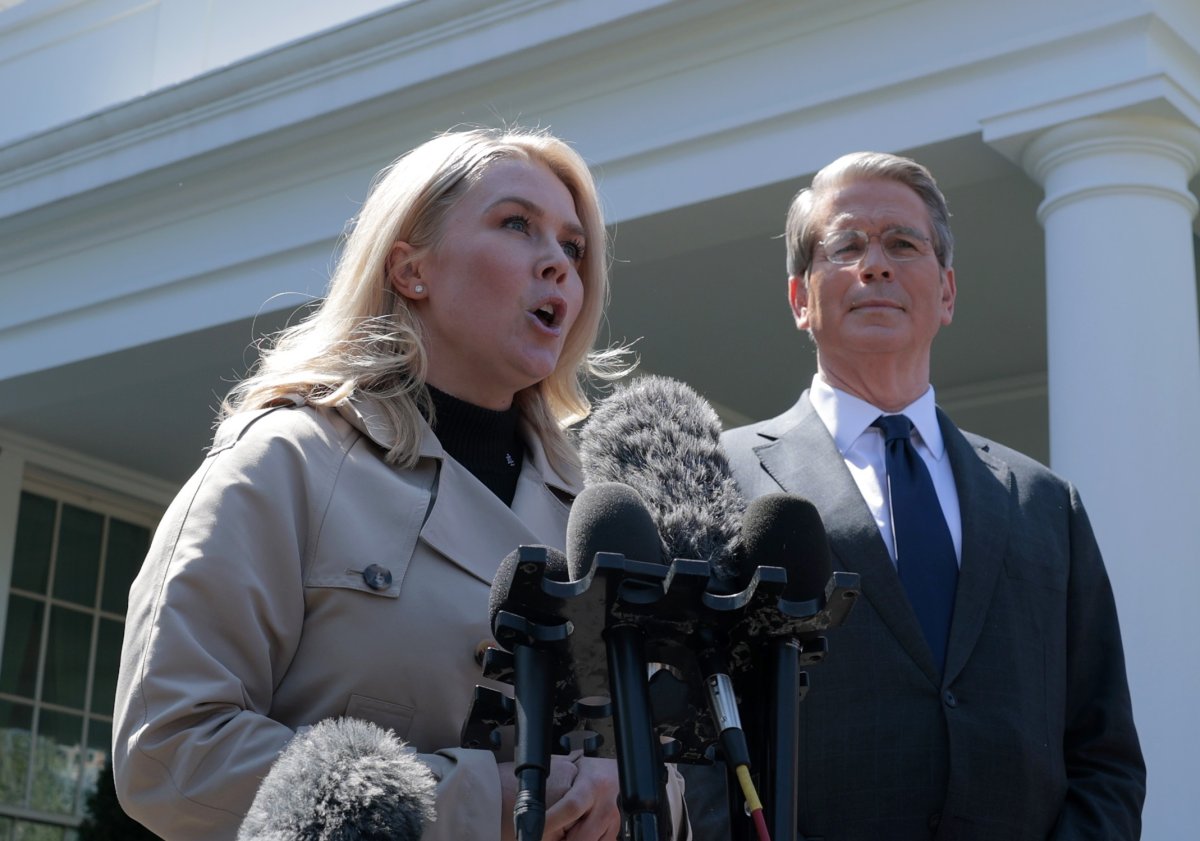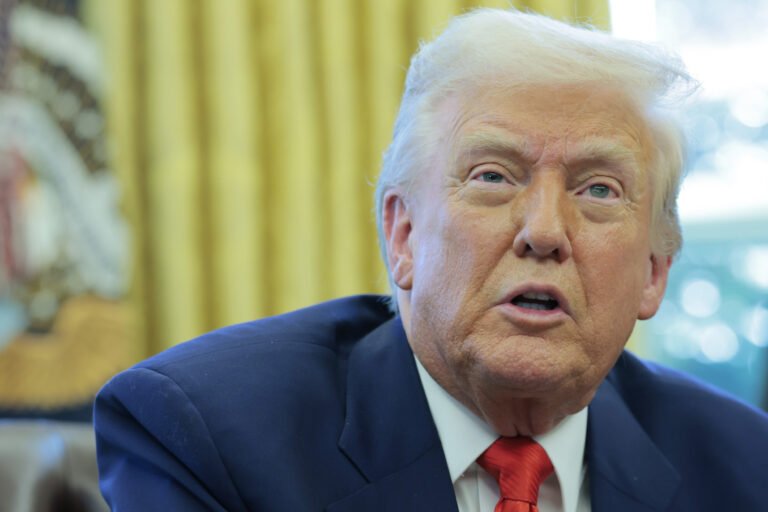White House press secretary Karoline Leavitt has said President Donald Trump’s sudden reversal on tariffs was all “the art of the deal,” a reference to Trump’s ghostwritten 1987 book.
Trump paused most of his “reciprocal” tariffs for 90 days—with China the big exception—amid sharp losses in the markets and fears of a recession.
Why It Matters
The White House moved quickly to frame Trump’s tariff pause as a shrewd negotiation step rather than one enforced by stock and bond market turmoil, as critics will suggest.
Either way, it was followed by a sharp U-turn for previously plunging global stock markets.
What To Know
“Many of you in the media clearly missed The Art of the Deal,” Leavitt told reporters alongside Treasury Secretary Scott Bessent outside the White House on Wednesday.
In the book, Trump discusses using an exaggerated opening demand to allow for compromise.
“You tried to say that the rest of the world would be moved closer to China when in fact we’ve seen the opposite. The entire world is calling the United States of America, not China, because they need our markets, they need our consumers. And they need this president in the Oval Office to talk to them.”

Anna Moneymaker/Getty Images
Trump said that a deal could now be made with any country during the 90-day pause, including China.
Treasury Secretary Scott Bessent previously said that almost 70 nations had reached out to negotiate down their duties, telling reporters outside the White House on Wednesday that this figure had now risen to 75.
The reciprocal tariffs, which came into effect on Wednesday after being announced by Trump last week, triggered a sharp downturn in global markets, wiping out trillions as concerns over their impact on international trade grew.
Prior to Trump’s announcement of the 90-day pause, the administration had been adamant that postponing the new duties was not on the table, and that the tariffs were not being used as a negotiation tactic. On Sunday, Commerce Secretary Howard Lutnick told CBS News: “There is no postponing, [the tariffs] are definitely going to stay in place for days and weeks. That is sort of obvious.”
Lutnick has now denied that the pause was put in place due to the market reaction.
“It was not. I will happily say definitively, it was not,” Lutnick told reporters. “Donald Trump is in charge of these policies and this direction. He is the greatest negotiator and the greatest person who understands—these are his goals and his objectives, and he is executing them.”
The president, however, suggested that he was paying close attention to the markets before and after making the decision.
“I think in financial markets, they change. Look how much it changed today,” Trump said during an event with car racing champions outside the White House. “We went from, uh, you know, pretty moderate today, but over the last few days, it looked pretty glum to I guess they say it was the biggest day in financial history.”
“I was watching the bond market. The bond market is very tricky, I was watching it,” he said, in response to a reporters question on whether the selloff in U.S. Government Treasuries had prompted the decision.
“But if you look at right now it’s beautiful. The bond market right now is beautiful.”

Anna Moneymaker/Getty Images
Wall Street rebounded sharply on the news. The S&P 500 ended the day 9.5 percent higher, the Dow Jones Industrial Average was up 7.9 percent, while the Nasdaq Composite had gained 12.2 percent.
Markets are also up abroad. Japan’s Topix index ended 8.1 percent higher, while the benchmark Nikkei 225 closed up 9.1 percent. The South Korean Kospi rose 6.6 percent on Thursday.
Hong Kong’s Hang Seng Index was up 2.2 percent higher in late afternoon trading, with China’s CSE 300 and SSE Composite having risen 1.3 and 1.2 percent, respectively, as of 3:39 ET.
The Euro Stoxx 50 was up 7.6 percent, the Stoxx Europe 600 up 6.9 percent and the FTSE 100 up 4.6 percent.
What People Are Saying
White House Press Secretary Karoline Leavitt, speaking to reporters on Wednesday, said: “Many of you in the media clearly missed the art of the deal. You clearly failed to see what president Trump is doing here.”
President Trump, speaking to reporters during a photo op on Wednesday, said: “You have to have flexibility. I could say, here’s a wall and I’m going to go through that wall. I’m going to go through it no matter what. Keep going, and you can’t go through the wall sometimes.”
“I thought that people were jumping a little bit out of line, they were getting yippy, ya know, they were getting a little bit yippy, a little bit afraid,” he added.
The White House’s official X account reposted a 2014 tweet from President Trump, in which he wrote: “Deals are my art form. Other people paint beautifully or write poetry. I like making deals, preferably big deals. That’s how I get my kicks.”
Treasury Secretary Scott Bessent, speaking outside the White House on Wednesday, said: “We saw the successful negotiating strategy that President Trump implemented a week ago today. It has brought more than 75 countries forward to negotiate. It took great courage—great courage for him to stay the course until this moment. And what we have ended up with here, as I told everyone a week ago there in this very spot: do not retaliate and you will be rewarded.”
Former IMF Chief Economist Simon Johnson told Newsweek prior to the announcement that he did not believe the tariffs were an effective negotiation tactic.
“There are deals you can make on energy or on non-tariff barriers, other things, but those deals you could make anyway,” Johnson said. “The EU, for example, was offering zero-for-zero on industrial tariffs with the US … They were offering that before Liberation Day, and they’re offering it again now, at least for the time being.”
“So no, I think as a negotiating tactic, it’s pretty pointless,” he added.
Fox News contributor Liz Peek, a former partner of Wall Street firm Wertheim & Company wrote in an op-ed published Tuesday: “In his book The Art of the Deal he explains the virtue of leading with an exaggerated demand, which allows for compromise. Presumably that is what he is doing now.
“The White House is under pressure to bring the public on board. Trump’s agenda, including extension of the 2017 tax cuts, could be in jeopardy if voters lose confidence and if the GOP loses control of Congress in the midterms.”
What Happens Next?
Reciprocal tariffs will be reduced to a baseline rate of 10 percent, while the U.S. considers negotiations with trading partners.China, having responded with its own tariffs on U.S. goods, will now face an increased tariff rate of 125 percent.


